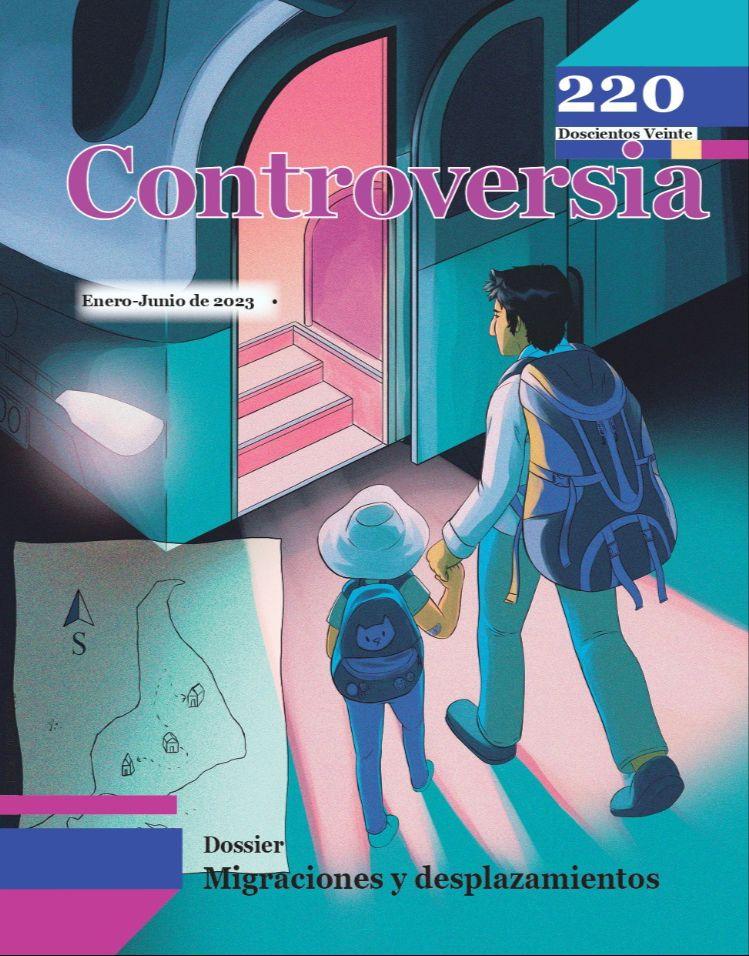Resumen
Este artículo tiene como objetivo describir el proceso de inserción laboral de lo/as migrantes colombiano/as indocumentado/as en Paterson, y destacar la relación entre esta inserción y la racialización de esta migración. La investigación muestra que la inserción laboral se lleva a cabo a través de una red de subcontratación que se basa en la criminalización y la segregación urbana como técnicas de racialización. Como resultado, los empleadores pueden controlar eficazmente el trabajo para satisfacer las necesidades de producción y acumulación de capital.
Referencias
Arango, Joaquín. (2000). Explaining migration: A critical view. International Social Science Journal, 52(165), 283-296. https://doi.org/https://doi.org/10.1111/1468-2451.00259
Baldassini, Jose G., y Flaherty, Vincent F. (1982). Acculturation process of Colombian immigrants into the American culture in Bergen County, New Jersey. International Journal of Intercultural Relations, 6(2), 127-135. https://doi.org/10.1016/0147-1767(82)90043-8
Banks, Marcus. (1985). An ethnographic study of students in English as a second language class: a case of colombian students. DAI-A, 47(2), 449.
Bourgois, Philippe. (2003). In search of respect. Selling crack in El Barrio. Cambridge University Press.
Castro, Mary. (1982). “Mary” and Eve’s social reproduction in the “big apple”. Colombian Voices. Occasional Paper, 35.
Charum, Jorge. (2001). La opción diáspora científica: Una nueva posibilidad de recuperación de las capacidades emigradas. Colombia: Ciencia y Tecnología, 19(2), 12-18.
Cohn, D'Vera. (2010). Census history: counting hispanics. Pew Research Center. Social y Demographic Trends. http://www.pewsocialtrends.org/2010/03/03/census-history-counting-hispanics-2/
Colleran, Kevin; Gurak, Douglas y Kritz, Mary. (1984). Migration, acculturation and family processes. HRC Research Bulletin, 7(3-4), 16.
De la Garza Toledo, Enrique. (2012). La subcontratación y la acumulación de capital en el nivel global. En Juan Carlos Celis Ospina (Ed.), La subcontratación laboral en América Latina: Miradas multidimensionales. Consejo Latinoamericano de Ciencias Sociales.
Díaz M., Luz Marina. (2008). Olvidados y ofendidos: esbozo histórico de la migración internacional colombiana. Desde la Región, (50), 15-22.
Du Bois, W. E. Burghardt. (1898). The study of the negro problems. Annals of the American Academy of Political and Social Science, 11, 1-23.
Du Bois, W. E. Burghardt. (2003). The souls of black folk. Barnes y Noble Classics.
Duque-Páramo, María Claudia. (2004). Colombian immigrant children in the United States: Representations of food and the process of creolization. http://scholarcommons.usf.edu/cgi/viewcontent.cgi?article=2020&context=etd
García, San Juanita. (2017). Bridging critical race theory and migration: Moving beyond assimilation theories. Sociology Compass, 11(6), e12484. https://doi.org/https://doi.org/10.1111/soc4.12484
Golash-Boza, Tania Maria. (2015). Deported: Immigrant policing, disposable labor, and global capitalism. New York University Press.
Gonos, George y Martino, Carmen. (2011). Temp agency workers in New Jersey’s logistic hub: The case for a union hiring hall. Journal of Labor and Society, 14(4), 499-525.
González-Aguilera, Sebastián. (2019). Viviendo en la jaula de oro. Racialización y mundo laboral de los colombianos indocumentados de Paterson, New Jersey. Universidad Nacional de Colombia.
Guarnizo, Luis Eduardo. (2004). Aspectos económicos del vivir transnacional. Colombia Internacional, 9(59), 12-47. https://revistas.uniandes.edu.co/doi/pdf/10.7440/colombiaint59.2004.01
Guarnizo, Luis Eduardo y Díaz, Luz Marina. (1999). Transnational migration: A view from Colombia Ethnic and Racial Studies, 22(2), 397-421. https://doi.org/10.1080/014198799329530
Guarnizo, Smith, Michael Peter y Guarnizo, Luis Eduardo (Eds.). (1998). Transnationalism from below. Transaction Publishers.
Hernández, Ramona. (2002). The mobility of workers under advanced capitalism. Dominican migration to the United States. Columbia University Press.
Jackson, Kenneth. (1987). Crabgrass frontier. The suburbanization of the United States. Oxford University Press.
Kail, Barbara; Zayas, Luis H. y Malgady, Robert G. (2000). Depression, acculturation, and motivations for alcohol use among young colombian, dominican, and puerto rican men. Hispanic Journal of Behavioral Sciences, 22(1), 64-77. https://doi.org/10.1177/0739986300221003
Laguerre, Michel S. (1998). Diasporic citizenchip. Haitians americans in transnational America. Palgrave Macmillan.
Linhart, Robert. (2013). De cadenas y de hombres. Siglo XXI Editores.
Massey, Douglas. (2014a). Manufacturing marginality among women and latinos in neo-liberal America. Ethnic and Racial Studies, 37(10), 1747-1752.
Massey, Douglas. (2014b). The racialization of latinos in the United States. En Sandra Bucerius y Michael Tonry (Eds.), The oxford handbook of ethnicity, crime, and immigration (pp. 21-40). Oxford University Press.
Massey, Douglas S. y Pren, Karen A. (2012). Origins of the new latino underclass. Race and Social Problems, 4(1), 5-17. https://doi.org/10.1007/s12552-012-9066-6
Molina, Natalia. (2014). How race is made in America: Immigration, citizenship, and the historical power of racial scripts. University of California Press.
New Jersey Department of Labor y Workforce Development Office of Research y Information. (2021). New Jersey’s transportation distribution y logistics industry cluster. https://www.nj.gov/labor/labormarketinformation/assets/PDFs/pub/empecon/tdl.pdf
O’Malley, Ann S.; Kerner, Jon; Johnson, Ayah y Manidelblatt, Jeanne. (1999). Acculturation and breast cancer screening among hispanic women in New York City. American Journal of Public Health, 89(2), 219-227. https://www.ncbi.nlm.nih.gov/pmc/articles/PMC1508521/pdf/amjph00002-0077.pdf
Olmos, Daniel. (2019). Racialized im/migration and autonomy of migration perspectives: New directions and opportunities. Sociology Compass, 13(9), e12729. https://doi.org/https://doi.org/10.1111/soc4.12729
Owusu, Thomas Y. (2014). Economic transition in the city of Paterson, New Jersey (America’s first planned industrial city): causes, impacts, and urban policy implications. Urban Studies Research, e672794.
PewResearchCenterPassel, Jeffrey y Conn, D'Vera. (2018). U.S. Unauthorized Immigrant Total Dips to Lowest Level in a Decade. Pew Research Center.
Pellegrino, Adela. (2001). Trends in Latin America skilled migration: “brain drain” or “braing exchange”? International Migration, 39(5), 111-132.
Pineda, Claudia Giovanna. (2008). Condiciones sociales y educación. En Ana Maria Bidegain, Maria Aysa-Latra y Brooke Wooldridge, Presencia Colombiana en Estados Unidos. Caracterización de la población migrante (pp. 185-192). Ministerio de Relaciones Exteriores.
Portes, Alejandro y Rumbaut, Rubén G. (2006). Immigrant America. A portrait (3.a ed.). University of California Press.
Rahmati Seyedeh Hoda y Tularam, Anand G. (2017). A criticar review of human migration models. Climate Change, 3(12), 924-952.
Reimers, David M. (1992). The western hemisphere: Mexico, Central and South America, and the Caribbean. En Still the golden door. The third world comes to America (2.a ed.). Columbia University Press.
Romero, Mary. (2008). Crossing the immigration and race border: A critical race theory approach to immigration studies. Contemporary Justice Review, 11(1), 23-37. https://doi.org/https://doi.org/10.1080/10282580701850371
Sáenz, Rogelio y Manges Douglas, Karen. (2015). A call for the racialization of immigration studies: On the transition of ethnic immigrants to racialized immigrants. Sociology of Race and Ethnicity, 1(1), 166-180. https://doi.org/10.1177/2332649214559287
Shaw, Douglas V. (1994). Immigration and ethnicity in New Jersey history. New Jersey Historical Commission, Department of State.
Smith, Robert Courtney. (2006). Mexican New York. Transnational lives of new immigrants. University of California Press.
Valdez, Zulema y Golash-Boza, Tanya. (2017). U.S. racial and ethnic relations in the twenty-first century. Ethnic and Racial Studies, 40(13), 2181-2209. https://doi.org/10.1080/01419870.2016.1262052
Wacquant, Loïc. (1996). The Rise of Advanced Marginality: Notes on its Nature and Implications. Acta Sociológica, 39(2), 121-139.
Wacquant, Loïc. (1999). Urban Marginality in the Coming Millenium. Urban Studies, 36(10), 1639-1647.
Wacquant, Loïc. (2015). Parias urbanos. Marginalidad en la ciudad a comienzos del milenio. Manantial.
Waldinger, Roger y Lichter, Michael. (2003). How the other half works. Immigration and the social organization of labor. University of California Press.
Weber, Max. (2014). Economía y Sociedad. Fondo de Cultura Económica.
Baldassini, Jose G., y Flaherty, Vincent F. (1982). Acculturation process of Colombian immigrants into the American culture in Bergen County, New Jersey. International Journal of Intercultural Relations, 6(2), 127-135. https://doi.org/10.1016/0147-1767(82)90043-8
Banks, Marcus. (1985). An ethnographic study of students in English as a second language class: a case of colombian students. DAI-A, 47(2), 449.
Bourgois, Philippe. (2003). In search of respect. Selling crack in El Barrio. Cambridge University Press.
Castro, Mary. (1982). “Mary” and Eve’s social reproduction in the “big apple”. Colombian Voices. Occasional Paper, 35.
Charum, Jorge. (2001). La opción diáspora científica: Una nueva posibilidad de recuperación de las capacidades emigradas. Colombia: Ciencia y Tecnología, 19(2), 12-18.
Cohn, D'Vera. (2010). Census history: counting hispanics. Pew Research Center. Social y Demographic Trends. http://www.pewsocialtrends.org/2010/03/03/census-history-counting-hispanics-2/
Colleran, Kevin; Gurak, Douglas y Kritz, Mary. (1984). Migration, acculturation and family processes. HRC Research Bulletin, 7(3-4), 16.
De la Garza Toledo, Enrique. (2012). La subcontratación y la acumulación de capital en el nivel global. En Juan Carlos Celis Ospina (Ed.), La subcontratación laboral en América Latina: Miradas multidimensionales. Consejo Latinoamericano de Ciencias Sociales.
Díaz M., Luz Marina. (2008). Olvidados y ofendidos: esbozo histórico de la migración internacional colombiana. Desde la Región, (50), 15-22.
Du Bois, W. E. Burghardt. (1898). The study of the negro problems. Annals of the American Academy of Political and Social Science, 11, 1-23.
Du Bois, W. E. Burghardt. (2003). The souls of black folk. Barnes y Noble Classics.
Duque-Páramo, María Claudia. (2004). Colombian immigrant children in the United States: Representations of food and the process of creolization. http://scholarcommons.usf.edu/cgi/viewcontent.cgi?article=2020&context=etd
García, San Juanita. (2017). Bridging critical race theory and migration: Moving beyond assimilation theories. Sociology Compass, 11(6), e12484. https://doi.org/https://doi.org/10.1111/soc4.12484
Golash-Boza, Tania Maria. (2015). Deported: Immigrant policing, disposable labor, and global capitalism. New York University Press.
Gonos, George y Martino, Carmen. (2011). Temp agency workers in New Jersey’s logistic hub: The case for a union hiring hall. Journal of Labor and Society, 14(4), 499-525.
González-Aguilera, Sebastián. (2019). Viviendo en la jaula de oro. Racialización y mundo laboral de los colombianos indocumentados de Paterson, New Jersey. Universidad Nacional de Colombia.
Guarnizo, Luis Eduardo. (2004). Aspectos económicos del vivir transnacional. Colombia Internacional, 9(59), 12-47. https://revistas.uniandes.edu.co/doi/pdf/10.7440/colombiaint59.2004.01
Guarnizo, Luis Eduardo y Díaz, Luz Marina. (1999). Transnational migration: A view from Colombia Ethnic and Racial Studies, 22(2), 397-421. https://doi.org/10.1080/014198799329530
Guarnizo, Smith, Michael Peter y Guarnizo, Luis Eduardo (Eds.). (1998). Transnationalism from below. Transaction Publishers.
Hernández, Ramona. (2002). The mobility of workers under advanced capitalism. Dominican migration to the United States. Columbia University Press.
Jackson, Kenneth. (1987). Crabgrass frontier. The suburbanization of the United States. Oxford University Press.
Kail, Barbara; Zayas, Luis H. y Malgady, Robert G. (2000). Depression, acculturation, and motivations for alcohol use among young colombian, dominican, and puerto rican men. Hispanic Journal of Behavioral Sciences, 22(1), 64-77. https://doi.org/10.1177/0739986300221003
Laguerre, Michel S. (1998). Diasporic citizenchip. Haitians americans in transnational America. Palgrave Macmillan.
Linhart, Robert. (2013). De cadenas y de hombres. Siglo XXI Editores.
Massey, Douglas. (2014a). Manufacturing marginality among women and latinos in neo-liberal America. Ethnic and Racial Studies, 37(10), 1747-1752.
Massey, Douglas. (2014b). The racialization of latinos in the United States. En Sandra Bucerius y Michael Tonry (Eds.), The oxford handbook of ethnicity, crime, and immigration (pp. 21-40). Oxford University Press.
Massey, Douglas S. y Pren, Karen A. (2012). Origins of the new latino underclass. Race and Social Problems, 4(1), 5-17. https://doi.org/10.1007/s12552-012-9066-6
Molina, Natalia. (2014). How race is made in America: Immigration, citizenship, and the historical power of racial scripts. University of California Press.
New Jersey Department of Labor y Workforce Development Office of Research y Information. (2021). New Jersey’s transportation distribution y logistics industry cluster. https://www.nj.gov/labor/labormarketinformation/assets/PDFs/pub/empecon/tdl.pdf
O’Malley, Ann S.; Kerner, Jon; Johnson, Ayah y Manidelblatt, Jeanne. (1999). Acculturation and breast cancer screening among hispanic women in New York City. American Journal of Public Health, 89(2), 219-227. https://www.ncbi.nlm.nih.gov/pmc/articles/PMC1508521/pdf/amjph00002-0077.pdf
Olmos, Daniel. (2019). Racialized im/migration and autonomy of migration perspectives: New directions and opportunities. Sociology Compass, 13(9), e12729. https://doi.org/https://doi.org/10.1111/soc4.12729
Owusu, Thomas Y. (2014). Economic transition in the city of Paterson, New Jersey (America’s first planned industrial city): causes, impacts, and urban policy implications. Urban Studies Research, e672794.
PewResearchCenterPassel, Jeffrey y Conn, D'Vera. (2018). U.S. Unauthorized Immigrant Total Dips to Lowest Level in a Decade. Pew Research Center.
Pellegrino, Adela. (2001). Trends in Latin America skilled migration: “brain drain” or “braing exchange”? International Migration, 39(5), 111-132.
Pineda, Claudia Giovanna. (2008). Condiciones sociales y educación. En Ana Maria Bidegain, Maria Aysa-Latra y Brooke Wooldridge, Presencia Colombiana en Estados Unidos. Caracterización de la población migrante (pp. 185-192). Ministerio de Relaciones Exteriores.
Portes, Alejandro y Rumbaut, Rubén G. (2006). Immigrant America. A portrait (3.a ed.). University of California Press.
Rahmati Seyedeh Hoda y Tularam, Anand G. (2017). A criticar review of human migration models. Climate Change, 3(12), 924-952.
Reimers, David M. (1992). The western hemisphere: Mexico, Central and South America, and the Caribbean. En Still the golden door. The third world comes to America (2.a ed.). Columbia University Press.
Romero, Mary. (2008). Crossing the immigration and race border: A critical race theory approach to immigration studies. Contemporary Justice Review, 11(1), 23-37. https://doi.org/https://doi.org/10.1080/10282580701850371
Sáenz, Rogelio y Manges Douglas, Karen. (2015). A call for the racialization of immigration studies: On the transition of ethnic immigrants to racialized immigrants. Sociology of Race and Ethnicity, 1(1), 166-180. https://doi.org/10.1177/2332649214559287
Shaw, Douglas V. (1994). Immigration and ethnicity in New Jersey history. New Jersey Historical Commission, Department of State.
Smith, Robert Courtney. (2006). Mexican New York. Transnational lives of new immigrants. University of California Press.
Valdez, Zulema y Golash-Boza, Tanya. (2017). U.S. racial and ethnic relations in the twenty-first century. Ethnic and Racial Studies, 40(13), 2181-2209. https://doi.org/10.1080/01419870.2016.1262052
Wacquant, Loïc. (1996). The Rise of Advanced Marginality: Notes on its Nature and Implications. Acta Sociológica, 39(2), 121-139.
Wacquant, Loïc. (1999). Urban Marginality in the Coming Millenium. Urban Studies, 36(10), 1639-1647.
Wacquant, Loïc. (2015). Parias urbanos. Marginalidad en la ciudad a comienzos del milenio. Manantial.
Waldinger, Roger y Lichter, Michael. (2003). How the other half works. Immigration and the social organization of labor. University of California Press.
Weber, Max. (2014). Economía y Sociedad. Fondo de Cultura Económica.
Descargas
La descarga de datos todavía no está disponible.




